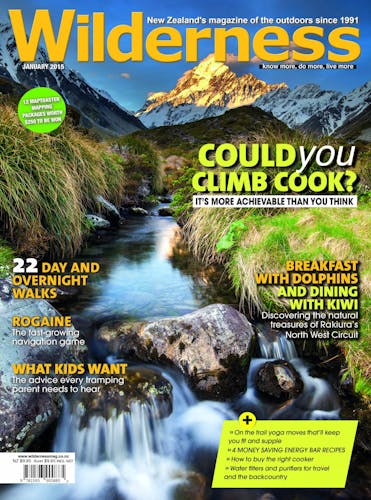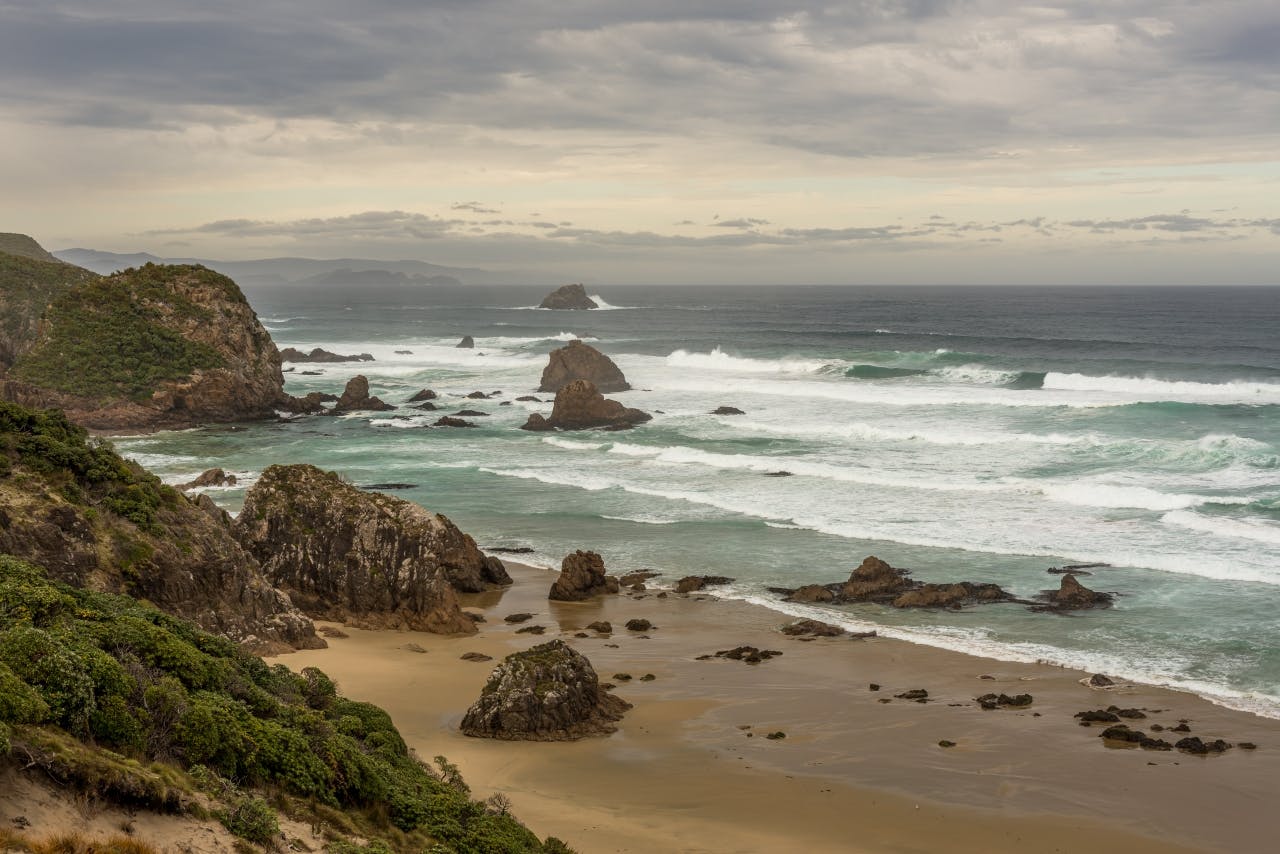- Time
- 8-10 days. Lee Bay to Bungaree Hut, 6-7hr; Bungaree Hut to Christmas Village Hut, 6hr; Christmas Village Hut to Yankee River Hut, 6hr; Yankee River Hut to Long Harry 5hr, Long Harry Hut to East Ruggedy Hut 5-6hr; East Ruggedy Hut to Big Hellfire Hut, 7-8hr, Big Hellfire Hut to Mason Bay Hut 7hr; Mason Bay Hut to Freshwater, 3hr
- Grade
- Moderate/Difficult
- Accom.
- Bungaree Hut, Christmas Village Hut, Yankee River Hut, Long Harry Hut, East Ruggedy Hut, Big Hellfire Hut, Mason Bay Hut, Freshwater Hut
- Access
- The North-West Circuit starts and ends at Oban on Stewart Island.
- Map
- CH08, CH09, CJ08, CJ09
On Stewart Island’s rugged North West Circuit, two trampers see more kiwi birds than Kiwi trampers, by Gillian Candler
Long Harry to East Ruggedy was the best of days and the worst of days. It was the day we battled driving rain, struggling along a wild bouldery beach. It was the day that my tramping companion said she felt like “Scott of the Antarctic” as we trudged through quicksand into a bitter cold wind on the last stretch to the hut. But it was also the day we encountered six Stewart Island kiwi (tokoeka) in the dark avenues of manuka.
Up until this moment we’d seen kiwi footprints on the muddy tracks and in the sand on the beach. We’d heard a kiwi call outside Yankee River Hut late at night and we’d read in hut books of other people’s kiwi sightings. We hoped to see at least one. On our fifth day on Stewart Island’s North West Circuit, about an hour or so from Long Harry Hut, we were descending to the hut’s old site and there, right in the middle of the track, was a large kiwi. Bigger and darker than I’d imagined, and such huge feet. As with the other kiwis we saw later, it seemed oblivious to our presence. We stayed to watch it fossicking among the crown ferns. Eventually it moved into the undergrowth and we continued on with a spring in our step, delighted with ourselves as if we’d somehow invoked this kiwi to appear. Within an hour we’d seen a further five of the flightless birds. Two were juveniles having a scrap, one poking its beak at the other’s backside as they ran through the ferns. Having seen off the intruder, the victor ambled back across the track less than a metre from my boots.
Those six kiwi meant we saw more kiwi than trampers on the North-West Circuit, despite being January and mostly fine weather.
Philippa and I started our tramp at Lee Bay near Oban. Despite our heavy loads of nine days’ worth of food, we made quick work of the first section which is shared with the Rakiura Great Walk and were soon on the muddier track beyond Port William Hut. From here, the track seemed to stretch like chewing gum and we began to wonder just how much longer the day would be, when finally we stepped out onto Big Bungaree Beach, saw the hut across the bay and felt wonderful relief.
We shared Bungaree Hut with Lawrence from France, who had already done enough tramping in New Zealand to have invested in a Backcountry Hut Pass.
From Bungaree we headed towards Christmas Village Hut, through kamahi, tree ferns and tall rimu and along sandy Murray Beach. From here, part of the route follows an old logging track among regenerating bush and then undulates into gullies and creeks.
Christmas Village Hut was a delight. We came upon it suddenly, looking up from the stony beach to see it sited on a grassy clearing right above the beach. In the morning we watched a pod of bottlenose dolphins from the deck as they swam by close to shore. Some trampers take a side trip up Mt Anglem, which at 980m is Stewart Island’s tallest peak. The really fit and super quick, such as Lawrence, could climb it in a day and tramp on to Yankee River, others stay two nights. For us, the North West Circuit was enough of a challenge.
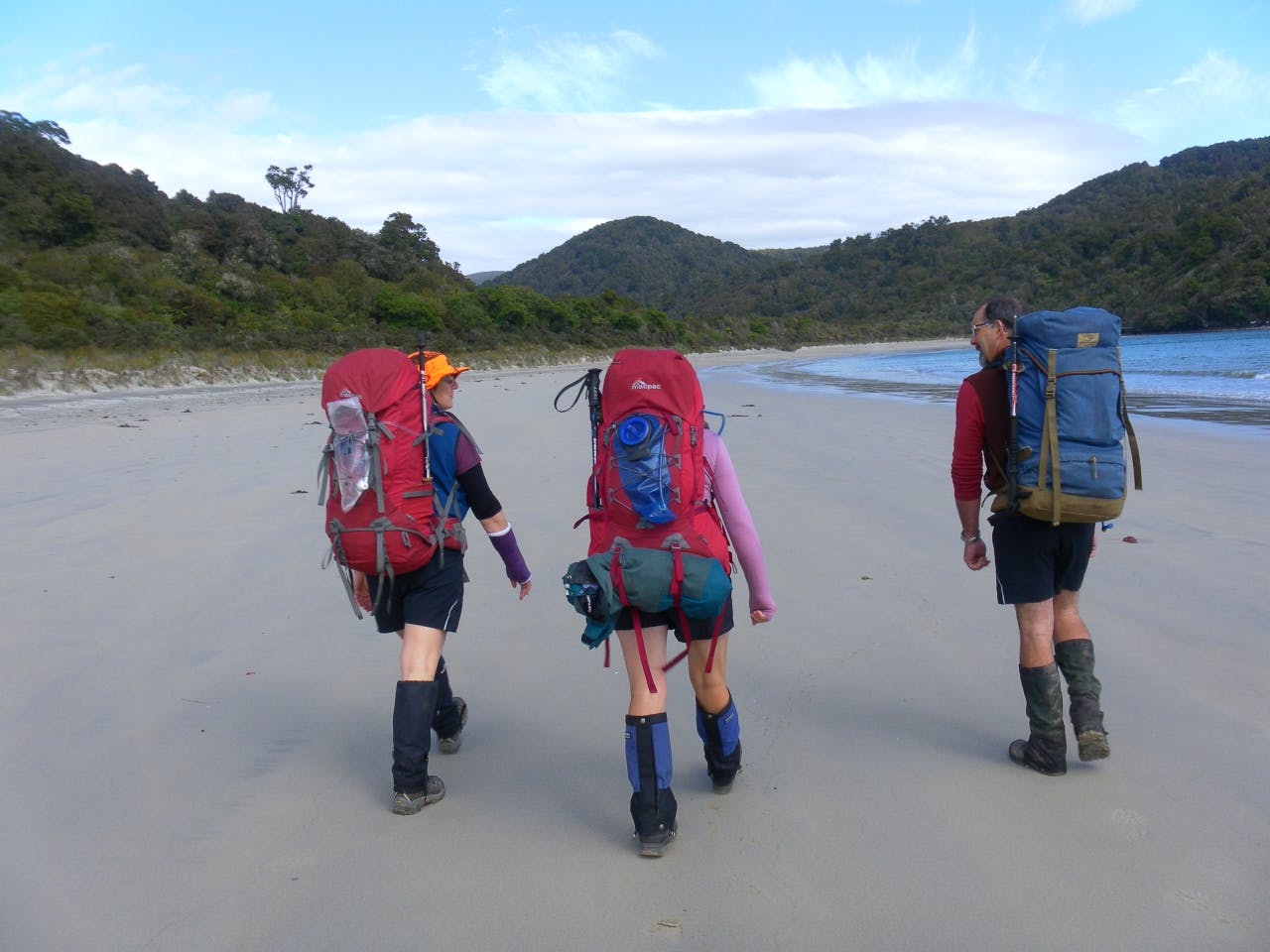
The first beach, shard with Great Walk trampers
After Christmas Village Hut we went through delightful rimu forest. The track was dry underfoot, the trees tall and laced with white cascades of winika orchids. Kakariki chattered in the canopy and fantails entertained us below.
The North West Circuit is essentially a coastal track, every day we walked along one or more beaches, climbed headlands or passes never higher than 400m and sidled slopes. On our third day, we came to Lucky Beach, which proved unlucky for us as the sandflies were numerous and we hadn’t left it far enough behind before stopping for lunch.
The setting for the next hut at Yankee River was also a treat. We sat in the hut and watched the tide flow up the river and then just as suddenly empty out. At night we heard yellow-eyed penguins and in the still of morning the trees were reflected in the mirror-like surface of the river. Just the sandflies stood between us and perfection.
By now there were five of us in the hut: Lawrence, and Fabian and Oliver, two young Germans, whom we’d met at Christmas Village Hut. Fabian and Oliver were on their gap year and had never tramped before. They had the largest portable gas cooker I’ve ever seen, a 5kg bag of rice and an equally large bag of oats. And they were carrying tins of fish. Our dehydrated food by comparison was a whole lot lighter and more varied but was considerably more expensive, fine for our one-off tramping trip but impossibly dear for a couple of young backpackers. It was one of the stark contrasts between us and the tourists we met. That and being old enough to be their mothers.
We developed a strong appreciation for their resilience.
We left Yankee River early, enjoying the morning sun shining through the canopy as we climbed through forest and then began the descent to Smoky Beach. The view of the beach was impressive: row after row of sand dunes stretching back into the bush. Down at the beach, we were faced with a steep dune about six metres high, at the top of which was the orange marker for the track. It wasn’t impossible or impassable, but it felt like a test. We were expecting another test at the end of the beach – would the river be low enough to wade across or would we be taking an extra hour to go up and over the bridge? We had to laugh; the river was only ankle deep.
Not long after Smoky Beach we came to huge boulders in the bush that created an ideal lunch shelter and invited further exploration. Shortly after that we caught sight of Long Harry Hut across a gully and made our way there, battling through muttonbird scrub, keen to get there before the weather turned for the worse. Once at Long Harry Hut, between the squalls of rain coming in, we had a view out to sea and over to the South Island.
Long Harry to East Ruggedy was meant to be a short day, so we again set out early hoping to arrive for lunch. Maybe our early start was the reason we saw so many kiwi, maybe it was just luck. Whichever it was, we arrived at East Ruggedy wet and exhausted but with a sense that we’d truly witnessed the best and the worst of nature.
A rest day at East Ruggedy was spent drying our clothes and sunning ourselves on the deck of the ‘Ritz’ as the hut has been dubbed. Our three companions had moved on and another young German, Benjamin, arrived. In the evening we listened to a chorus of hidden kiwi in the amphitheatre of crown ferns behind the hut.
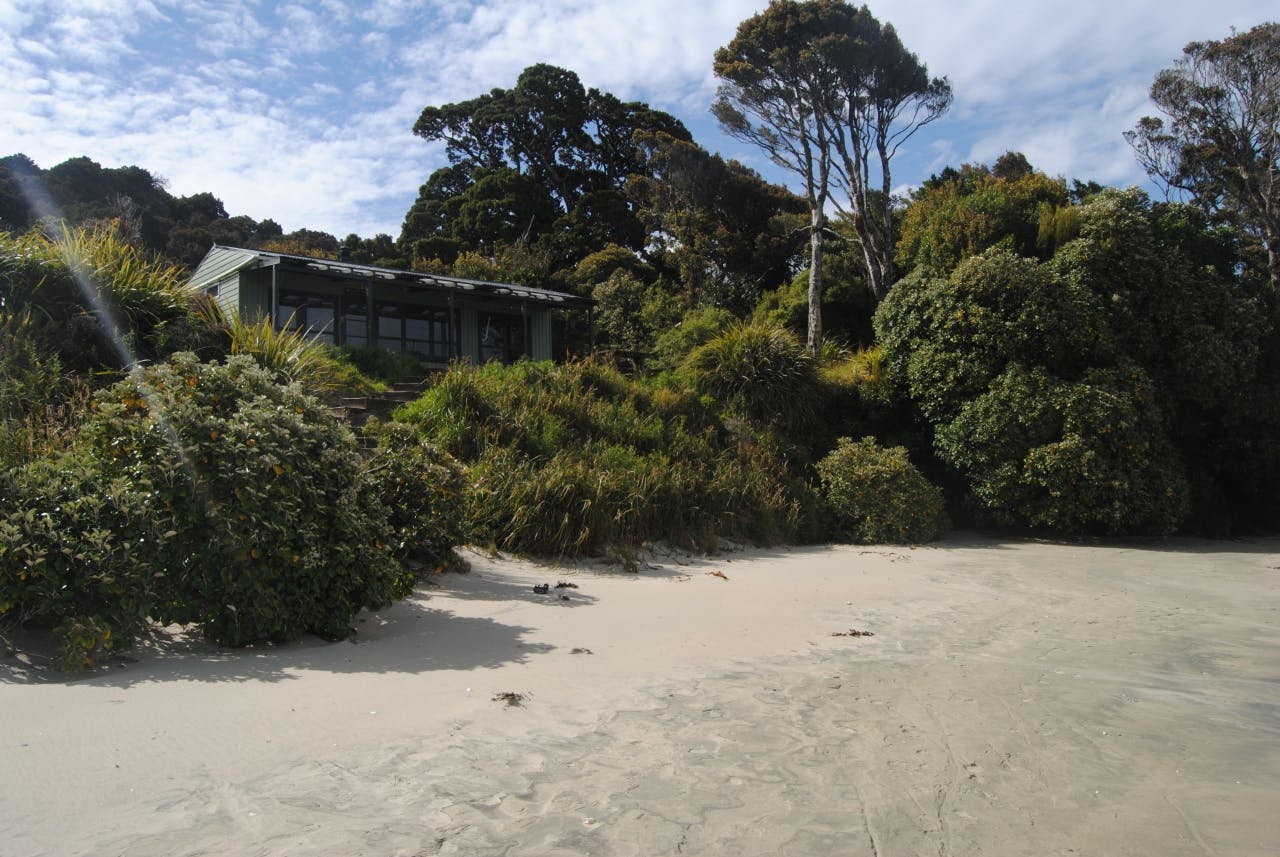
With 12 bunks, Bungaree Hut is one of the smaller huts on the circuit
The hut books made entertaining reading, filled with animal sightings, hard luck stories, moans about other people’s mess, or useful trail tips. In the East Ruggedy book someone had drawn a diagram showing how to get around the rocks on West Ruggedy that are impassable at high tide. It worked a treat. West Ruggedy Beach was wild and extraordinary. We were no longer facing north, but instead west out into the Tasman. Further on we crossed the Ruggedy Range, and Codfish Island/Whenua Hou came into view.
We’d been told the track to Big Hellfire Hut would have some of the worst mud we’d encounter. It was true. At times it was like wading upstream in a wide river of mud. We had become skilled at reading mud by then, figuring out where would be deepest, sloppiest or firmest. But here we couldn’t avoid being sucked into it. At times we fell forwards, sideways out of it or slipped deeper into it. In an extraordinary understatement, the DOC pamphlet lists gaiters as ‘recommend’ rather than ‘essential’. Every night ours were caked in mud up to our knees, and we’d rinse them in a river or beat the mud off, not wanting to carry any extra weight the next day.
Big Hellfire Hut was a surprise. Despite reading all the track descriptions we hadn’t quite taken in that there was a huge sand dune by the hut. Benjamin ran down it to have a swim in the ocean. We stayed and admired the view from Big Hellfire into the interior of swampy Freshwater Valley, watching the colours of the land change as the sun set.
From Big Hellfire we headed to Mason Bay, another long day, and another rock to negotiate before high tide. The track between East Ruggedy and Mason Bay was the roughest, and toughest, but there was help along the way. Dropping down the final steep section to the bay, we found ropes had been tied in place as handholds, without which I’m sure we’d have slithered all the way down. At Mason Bay, we knew there was still two hours walking to Mason Bay Hut. A couple of friends came along the beach to meet us from the hut, a pleasant distraction that took our minds off the length of the beach.
Although there were only six of us in the hut that night, Mason Bay Hut is a relatively popular destination. It can be reached by taking a water taxi from Oban to Freshwater Hut and then a flat walk from Freshwater for three to four hours. This is what our friends had done and was the way we planned to return to Oban.
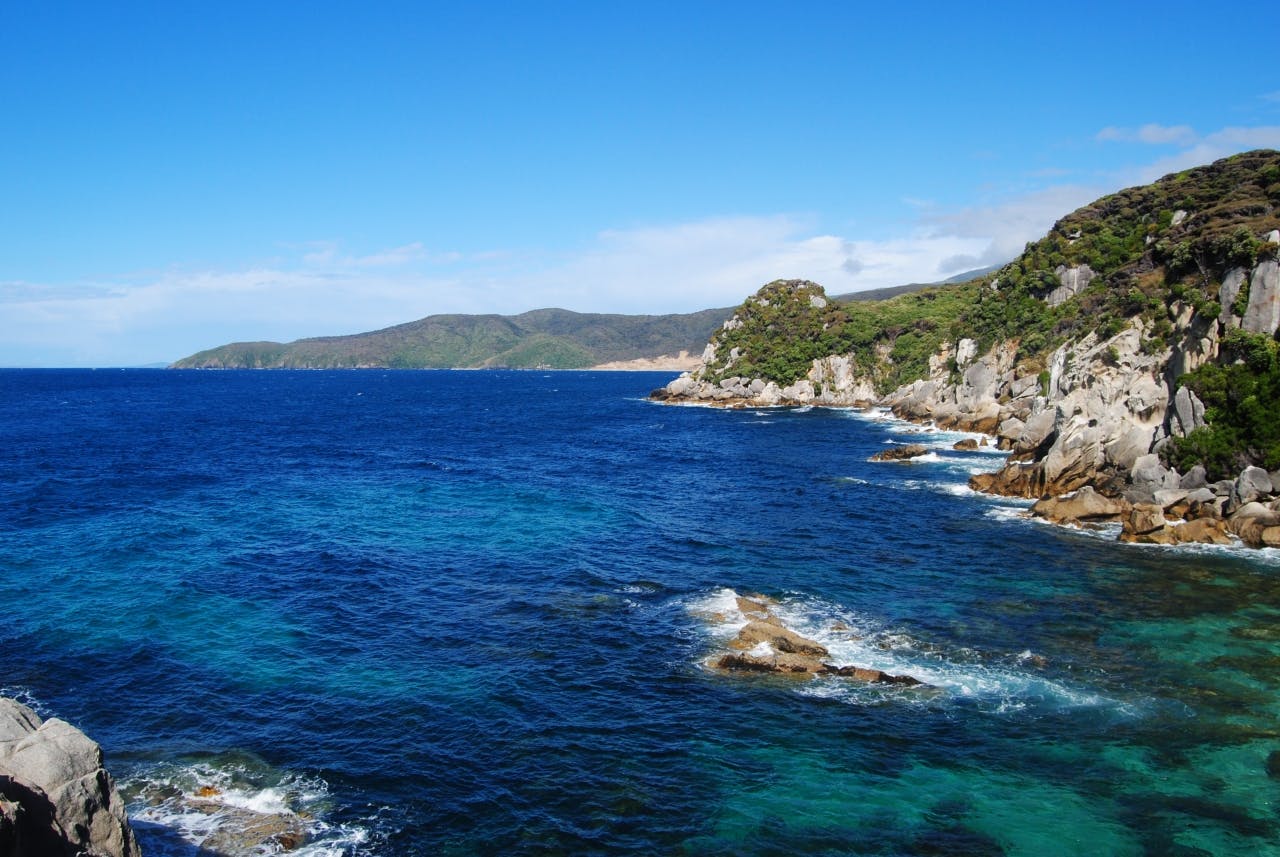
The coast from near Long Harry Hut, Smoky Beach in the distance
The next morning, we walked around the dune system watching banded dotterels scooting along the sand. Unfortunately bumblebees have taken a hold here and become a pest. They were nesting under the deck of the hut and one stung me.
In the afternoon we set off for Freshwater Hut. The walk through Freshwater Swamp was quite different from other sections of the circuit and we admired the unusual colours of the water and the grasses. We were rewarded for walking quietly by the sighting of a Stewart Island robin.
The North West Circuit has a reputation as a rugged tramp for the hardy. Five years ago when I started tramping, it seemed out of reach. Judging by how few Kiwi trampers are recorded in the hut books, it seems this reputation is putting people off walking it.
It’s a shame – they’re missing out on something very special.





